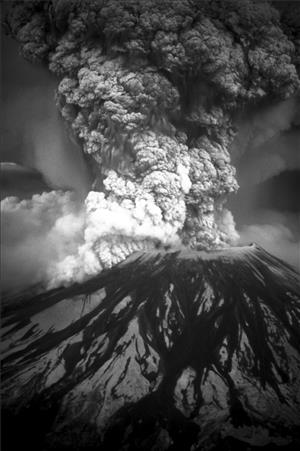On May 20, 1980, two days after the eruption of Mount St. Helens on May 18, some 2,500 motorists -- more than Ritzville's own population -- are stuck in Ritzville. They are jammed into school gyms, hospital corridors, churches and restaurants. By May 20, hundreds of them are so tired and impatient that they defy police orders and attempt to drive out of Ritzville despite the fact that Interstate 90 and other roads are officially closed. Most of them don't get more than a few miles before the gritty blowing ash forces them to turn back. Many motorists end up stalled on the shoulders and have to be rescued. A few make it as far as the Schrag Rest Area, about 22 miles west, but fewer than 100 make it out.
In the Volcano's Path
Ritzville was directly in the path of the ash cloud on May 18, 1980, and was hit harder than nearly any other spot in Eastern Washington. Four to six inches of ash covered every surface, with drifts as high as two feet. When the mountain blew, thousands of motorists were traveling cross-state on weekend excursions -- including many coming from Spokane's Lilac Festival Parade -- and were forced to pull into Ritzville when visibility was reduced to nothing.
Ritzville's motels were quickly overmatched. Hundreds of people were herded into the school gymnasium, which quickly filled. By the end of the day, crowds were gathered in every restaurant and church. Residents opened up their homes. Ritzville's 20-bed hospital was crowded with people suffering from respiratory problems -- and the hallways were jammed with those who had nowhere else to go.
The hospital's director of nursing said she was "seeing quite a bit of mass panic because you can't move." She said the "wind is blowing so hard that it burns your throat and eyes" whenever you take a step outside ("Ritzville floored").
"People in surrounding communities don't understand this because they didn't get hit as hard," said the nursing director. "You can't leave. You can't even open the door. It's like being in a flour sack and having someone pound the sides on you. It's frightening and these people are frightened. They are a long way from home" ("Ritzville floored").
So two days after the eruption, a large group of "rebel motorists" chose to ignore official warnings and try to make an escape from Ritzville. Most turned around within a few miles as they encountered nasty, gritty ground blizzards of ash. Some had to pull over when their clogged cars died. Police said didn't know how many cars made it out, but they said it wasn't more than 100.
Some travelers just felt fortunate to hole up in such a safe and hospitable city. "If you're ever going to get stuck somewhere, Ritzville is the place to do it," said one Moses Lake man ("Ritzville floored").
Shoveling Ash
Shoveling the ash proved to be devilishly difficult -- there was nowhere to put it. When trucks plowed it to the side, it just blew back on the road. However, over the next few days most of the stranded travelers trickled out of Ritzville -- although abandoned cars still littered the freeway.
Ritzville residents, on the other hand, had no choice but to stay and clean up. In August, teams of workers were still shoveling ash out of Ritzville's alleys.

